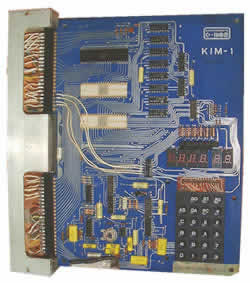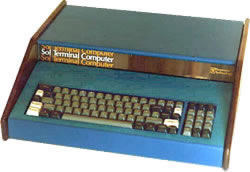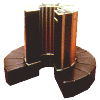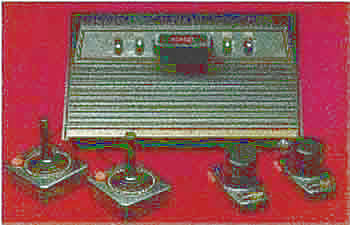click on the home button to go to the home page
|
The Industrial Era 1976 - 1977 The Third Generation of computers started approximately in this era. Computers are characterized by mainly electronic models and were fully programmable. |
pre history | antiquity |
pre industrial era | industrial
era
| 1947 | 1950 | 1952 | 1955 | 1958 | 1961 | 1963 | 1965 | 1969 | 1970 | 1972 | 1974 | 1976 |
| 1978 | 1980 | 1981 | 1982 | 1984 | 1986 | 1989 | 1991 | 1993 | 1994 | 1996 | 2000 | 2002 |
| Related Articles |
| Related Resources |
history of videogames |
![]() Z80 microprocessor
from Zilog was available in February. The first computer that used this CPU
was the Z-1 from Cramenco.
Z80 microprocessor
from Zilog was available in February. The first computer that used this CPU
was the Z-1 from Cramenco.
![]() The 6501 and 6502 micro processor
was developed by MOS Technology Corporation. Its relative low price (25US$)
was the reason why Steve Wozniak selected this processor for his first computer
the Apple I (the predecessor of the Apple II). The 6502 processor was
soon to be used in Commodore computers. At this point the Intel 8080 cost about
US$150.
The 6501 and 6502 micro processor
was developed by MOS Technology Corporation. Its relative low price (25US$)
was the reason why Steve Wozniak selected this processor for his first computer
the Apple I (the predecessor of the Apple II). The 6502 processor was
soon to be used in Commodore computers. At this point the Intel 8080 cost about
US$150.
|
The Homebrew computer club That summer in 1975 at the Homebrew Club the Intel 8080 formed the center of the universe. The Altair was built around the 8080 and its early popularity spawned a cottage industry of small companies that either made machines that would run programs written for the Altair or made attachments that would plug into the various kinds of micro computers.
|
![]() It is on the Homebrew Computer
club in Palo Alto, California (Silicon Valley), that Steve Wozniak, 26 years
old, working at Hewlett-Packard and a long time hacker, wished to have his own
computer. He already designed several computers on paper and even wrote FORTRAN
and Basic interpreters for these theoretical machines, but lack of money left
these machines in the theoretical phase. He was interested in the Intel 8080
chip (the heart of the Altair), but decided that $179 was too much money. This
decision not to use the 8080 was regarded as a stupid move by the other members
of the club.
It is on the Homebrew Computer
club in Palo Alto, California (Silicon Valley), that Steve Wozniak, 26 years
old, working at Hewlett-Packard and a long time hacker, wished to have his own
computer. He already designed several computers on paper and even wrote FORTRAN
and Basic interpreters for these theoretical machines, but lack of money left
these machines in the theoretical phase. He was interested in the Intel 8080
chip (the heart of the Altair), but decided that $179 was too much money. This
decision not to use the 8080 was regarded as a stupid move by the other members
of the club.
The thing with microprocessors was that a program or device designed for it
would not work on any other processor. The "connection" for devices
for the Altair was known as the S-100 bus because it used one hundred signal
lines. Disciples of the 8080 made attachments to the 8080 and S-100 even though
they readily admitted that the s-100 bus was poorly designed. The people who
wrote programs or built peripherals for 8080 computers thought that later competing
microprocessors were doomed. The sheer weight of the programs and the choice
of peripherals, so the argument went, would make it more useful to more users
and more profitable for more companies. The 8080, they liked to say, had critical
mass which was sufficient to consign anything else to oblivion."
![]() The market
demanded floppy disks with a larger capacity. As a reaction on this IBM launched
a floppy disk that could use both sides what brought the capacity to a whopping
360 Kb.
The market
demanded floppy disks with a larger capacity. As a reaction on this IBM launched
a floppy disk that could use both sides what brought the capacity to a whopping
360 Kb.
![]() More than 50 different microprocessors
were on the market at this time. Examples: AMI, Mostek, Motorola, National Semiconductor,
RCA, Rockwell, Signetics, Teledyne Systems and Toshiba.
More than 50 different microprocessors
were on the market at this time. Examples: AMI, Mostek, Motorola, National Semiconductor,
RCA, Rockwell, Signetics, Teledyne Systems and Toshiba.
 |
lOptical diodes Inc. (Frontier Inc) and MOs Technology Corp. produced the 6502 micro processor and the KIM a 6502 evaluation kit that could, with a lot of effort and creativity, be turned into a computer. The kit has a 1 MHz 6502 CPU, 1 Kb RAM, 2 Kb ROM, a 23 key keypad, LED readout, cassette and serial interfaces. All this for only US$245. |
![]() Digital shipped
WPS-8 a word-processor program.
Digital shipped
WPS-8 a word-processor program.

![]() Lee Felstein
build the SOL-20 computer (10K RAM), named
after a Popular Electronics editor Les Solomon. The typewriter machine keyboard-cum-computer
used a TV as monitor. It sold for $1649 as a kit, but if you wanted to avoid
the soldering you had to pay $2129 for a complete assembled kit.
Lee Felstein
build the SOL-20 computer (10K RAM), named
after a Popular Electronics editor Les Solomon. The typewriter machine keyboard-cum-computer
used a TV as monitor. It sold for $1649 as a kit, but if you wanted to avoid
the soldering you had to pay $2129 for a complete assembled kit.
![]() The first software
written for the Sol-20 machine was 'Electric Pencil, a word processor written
by Michael Schrayer (December). It seemed that the program is still available
in 2000!
The first software
written for the Sol-20 machine was 'Electric Pencil, a word processor written
by Michael Schrayer (December). It seemed that the program is still available
in 2000!

![]() The
first supercomputer
was created by Seymour Cray the
Cray 1, to be superseded quickly by the supers of Control Data (CYBER) and
Japanese firms like NEC (SX), FUJITSU, and HITACHI.
The
first supercomputer
was created by Seymour Cray the
Cray 1, to be superseded quickly by the supers of Control Data (CYBER) and
Japanese firms like NEC (SX), FUJITSU, and HITACHI.
The CRAY-1 was however the first commercial available machine that broke the
barrier of the magical 1 MIPS.
If you went the conventional route and tried to build one yourself using PC's
it would take 200.00 of them all cross connected (5), or you
could just purchase 33.33 Sun4s. CRAY Research INC made at least 16 of their
fabulous CRAY 1's A typical CRAY 1 would cost about 700,000 dollars. You could
order the machine in any color you wished and that still holds true today.
![]() RCA introduced
the 1802 microprocessor. Later it is used in a RCA COSMAC VIP system developed
by Joseph Weisbecker. It included 2 Kb RAM, 512 bytes of ROM, and an interface
for Video, Cassette and Audio.
RCA introduced
the 1802 microprocessor. Later it is used in a RCA COSMAC VIP system developed
by Joseph Weisbecker. It included 2 Kb RAM, 512 bytes of ROM, and an interface
for Video, Cassette and Audio.
![]() Ethernet, which
allows coaxial cable to move data extremely fast, is described by Robert M.
Metcalfe. This is a crucial component in development of LANs. (local area network)
Ethernet, which
allows coaxial cable to move data extremely fast, is described by Robert M.
Metcalfe. This is a crucial component in development of LANs. (local area network)
![]() First issue of
Dr. Dobb's Journal in January 1976, a magazine primarely devoted to system programmers.
First issue of
Dr. Dobb's Journal in January 1976, a magazine primarely devoted to system programmers.
![]() Dennis
C. Hayes invents the PC modem, establishing the critical
technology that will allow online and Internet industries to emerge and grow.(9)
Dennis
C. Hayes invents the PC modem, establishing the critical
technology that will allow online and Internet industries to emerge and grow.(9)


![]() On
1 April Apple Corporation is founded by Steve Wozniak and Steve Jobs. They developed
the Apple I and introduced the term: Personal Computer. Their first production
facility is the family garage.
On
1 April Apple Corporation is founded by Steve Wozniak and Steve Jobs. They developed
the Apple I and introduced the term: Personal Computer. Their first production
facility is the family garage.
The Apple 1 had a motherboard into which expansion cards could be plugged. The
programming language was BASIC which was licensed by Microsoft BASIC to Apple
and burned into a EPROM chip.

In April Apple introduced the Apple II on the West Coast Computer Fair in San Francisco. The computer contained an integrated keyboard, graphical screen, 8 expansion ports and a EPROM containing BASIC. Some innovations such as a "higher" programming language with graphic instructions will only be made available in other PC’s until the 90’s. The Apple II was based on the Motorola 6502 processor and could hold up 64 Kb RAM. The introduction price of the Apple II was 298 US$. The newer color model: 1250 Sterling Pound. The Apple II produced brilliant color graphics when hooked up to a color TV. |
![]() In a fast pace
8 bit microprocessors (such as: Intel 8080/6/8, Motorola 6800, Zilog Z80 and
MO's 6502) were integrated into Personal Computers.
In a fast pace
8 bit microprocessors (such as: Intel 8080/6/8, Motorola 6800, Zilog Z80 and
MO's 6502) were integrated into Personal Computers.

![]() Atari
releases the Atari 2600 home video
game console, another but very succesfull one based on the 8 bit 6502 chip.(6)
Atari
releases the Atari 2600 home video
game console, another but very succesfull one based on the 8 bit 6502 chip.(6)
![]() Interactive
System Corp. starts selling Unix commercially. UNIX is introduced into the IBM
360 System. Up to this time UNIX could only run on DEC PDP minicomputers. The
University of California at Berkeley released its own version of the UNIX operating
system called version 4xBSD. The package included a Pascal interpreter, a Pascal
shell and a selection of hardware drivers.
Interactive
System Corp. starts selling Unix commercially. UNIX is introduced into the IBM
360 System. Up to this time UNIX could only run on DEC PDP minicomputers. The
University of California at Berkeley released its own version of the UNIX operating
system called version 4xBSD. The package included a Pascal interpreter, a Pascal
shell and a selection of hardware drivers.
![]() The first implementation
of TCP (Transaction Control Program) was a fact. TCP is a protocol or tool that
allowed computers to be connected via different networks to communicate with
each other.
The first implementation
of TCP (Transaction Control Program) was a fact. TCP is a protocol or tool that
allowed computers to be connected via different networks to communicate with
each other.
![]() In this year
100 hosts are connected to the ARPAnet .
In this year
100 hosts are connected to the ARPAnet .
![]() Digital introduced
the VAX-11/780 the first member of the succesfull VAX series of computers.
Digital introduced
the VAX-11/780 the first member of the succesfull VAX series of computers.

Although the KIM set sold well for evaluation boards, Chuck Peddle of
Commodore was not pleased with the product. Instead he was looking for
a more user friendly product that could be used by the masses. As a result
Commodore developed the PET 2001 based on the 6502 chip. The Pet had a
futuristic design and had a cream colored casing. On the mainboard you
could find: 4Kbyte of memory (expandable to 32 Kbytes), a 8 Kbyte Microsoft
Basic EPROM, a Keyboard, Display and Cassette interface. The PET had a
40 characters wide screen. The computer caused an enormous sensation on
the Consumer Electronic show in Chicago (January). It is the first personal
computer with color display.
|
|
 Tandy (Radio
Shack) introduced their version of a Personal Computer the TRS-80-1.
Undeserved the computer receives the name: TraSh 80. The standard model
consisted of a console with a keyboard and cassette deck for data storage
but was delivered without a monitor. It had 4Kbyte RAM and 4Kbyte ROM containing
BASIC. The TRS-80 was the first ready to go computer. The TRS-80 sold for
$599.95 and came with "easy to understand" manuals for beginners. Tandy (Radio
Shack) introduced their version of a Personal Computer the TRS-80-1.
Undeserved the computer receives the name: TraSh 80. The standard model
consisted of a console with a keyboard and cassette deck for data storage
but was delivered without a monitor. It had 4Kbyte RAM and 4Kbyte ROM containing
BASIC. The TRS-80 was the first ready to go computer. The TRS-80 sold for
$599.95 and came with "easy to understand" manuals for beginners.
|
![]() The idea of
Open Systems (OSI) came in sight. Open Systems Interconnection started to research
possibilities how to let different types of computers to communicate with each
other.
The idea of
Open Systems (OSI) came in sight. Open Systems Interconnection started to research
possibilities how to let different types of computers to communicate with each
other.

![]() Under the management
of Allen Shugart the IBM research team reduced the 8inch floppy to a 5.25inch
size. These smaller floppy’s were more stable and easier to carry and handle.
This size became a defacto standard for many brands of micro computers. The
initial prize for the diskdrives was 390U$
Under the management
of Allen Shugart the IBM research team reduced the 8inch floppy to a 5.25inch
size. These smaller floppy’s were more stable and easier to carry and handle.
This size became a defacto standard for many brands of micro computers. The
initial prize for the diskdrives was 390U$
![]() Intel introduced
the 16bit 8086 chip and the 8087 co-processor. These chips caused a lot of excitement
but were not quickly adapted because they were ahead of their time (2). Only years later descendants of these chips would dominate
the market.
Intel introduced
the 16bit 8086 chip and the 8087 co-processor. These chips caused a lot of excitement
but were not quickly adapted because they were ahead of their time (2). Only years later descendants of these chips would dominate
the market.
![]() First 64Kb RAM
chip become mass produced by IBM.
First 64Kb RAM
chip become mass produced by IBM.
![]()
 Paul
Allen and Bill gates signed an agreement to officially found the Microsoft company(3)
Paul
Allen and Bill gates signed an agreement to officially found the Microsoft company(3)
![]() First computerized
word processor introduced by Wang Laboratories. Price: $30,000.(8)
First computerized
word processor introduced by Wang Laboratories. Price: $30,000.(8)
|
Another of those: "he could not be wrong more" Ken Olsen, founder of Digital Equipment Corporation, states: There is no reason anyone would want a computer in their home. |
![]() First
issue of Personal Computing Magazine in January 1977,
First
issue of Personal Computing Magazine in January 1977,
![]()
| Last Updated on October 25, 2004 | For suggestions please mail the editors |
Footnotes & References